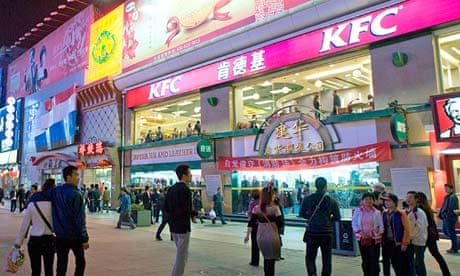Just south of the Forbidden City, past Mao Zedong's palatial mausoleum and across the road from Tiananmen Square, there is a more contemporary monument to Chinese life: the country's first KFC, established in 1987.
The atmosphere in the outlet is as chaotic and diverse as the city beyond. A moustachioed teenager tries to sell a fake Rolex to a woman with a Prada handbag. Two old men in paint-spattered khakis laugh over coffee. A toddler sticks french fries into her ice cream cone.
It was with this first outlet that KFC pioneered western fast food in mainland China. Its parent company, Kentucky-based YUM! Brands – which also owns Pizza Hut and Taco Bell – now operates almost 4,500 outlets in the country; more than four out of five of them are KFCs.
YUM! makes half its profits in China and the pace at which it is opening new outlets is still ferocious – it plans another 700 outlets there next year. McDonald's, its closest competitor, has about 2,000.
Yet recent months have not been kind to KFC in China. The chain's same-store sales dropped 4% year-on-year in the past quarter; they had risen 21% in the same period last year. One day in late November, its share price dropped almost 10%.
Conversations with KFC customers reveal the changing relationship between the Chinese and western fast food. "This place is quick, it's convenient, it's sanitary, it's safe," said retired official Mrs Wang, 73, before biting into a spicy chicken sandwich. Huang Chong, a 26-year-old teacher, was less enthusiastic. "Originally people thought KFC was great because it was from the west and really expensive," she said. "But now people just think it's junk food."
Many of the reasons for KFC China's recent troubles are macroeconomic – the country's GDP growth is slowing, even as labour costs and property prices rise. Yet analysts believe there are other factors at work. Chinese consumers are doing more of their shopping online, leaving once-lucrative shopping malls empty. As they grow richer, they've begun to regard eating at KFC as less of a sign of status. They are also becoming more health-conscious.
Then there was the recent "45-day chicken" food safety scare – an episode that laid bare the fragility of brand reputations.
In late November, Chinese media accused one of the chain's Shanxi province-based suppliers of pumping its chickens full of noxious chemicals to ensure they were fully grown within 45 days. "Reports claimed that the feedstuff Suhai prepared was so toxic it could even kill flies," said Xinhua, the country's official newswire.
A Chinese Central Television report which aired last month accused another KFC supplier, Liuhe Group, of feeding its chickens a cocktail of illegal drugs and antibiotics.
It is unclear whether or not the accusations constitute true-to-form food safety scandals, like the glowing pork, exploding watermelons and foul recycled oil that have made Chinese consumers hyperconscious about what and where they eat. KFC immediately denied the allegations about Suhai, and shortly afterwards, Shanxi provincial authorities concluded that the supplier's meat passed national standards. The chain has severed its ties with Liuhe and has agreed to "actively co-operate" with a government investigation into its use of antibiotics.
But it was enough for social media users to take a hatchet to KFC's reputation. One called the chain Kentucky Toxic Chicken. "American people don't eat it, so they take their poisonous garbage and bring it to China?! Resolutely do not eat it!" wrote one user on Sina Weibo, China's most popular microblog, which has 400 million users. 85% of respondents to a Sina Weibo poll said that they believed KFC and McDonald's chicken products were unsafe. Three quarters said that they would stop eating them.
"There is a massive social response against fast-growing chicken," said Yifeng Mao, the head of research at Shanghai-based Goldpebble Research. He added that a KFC executive brushed off questions about the scandals at an analyst meeting in New York this month. "We think KFC or YUM! – those guys in the US – underestimate the severity of the food safety thing," he said.
Meanwhile, the competition KFC faces is fierce. McDonald's has promised that by 2015 it will be opening a new restaurant in China every day. Burger King has announced plans to open 1,000 outlets by the end of the decade, presenting itself as a fresher, classier alternative to McDonald's. Chargrilled burger chain Carl's Jr has started popping up in Shanghai, and Californian chain Fatburger in Beijing.
"When McDonald's used to come to town, in second and third-tier cities, it was a big thing, like you'd arrived as a town," said Paul French, chief China market strategist at the market research firm Mintel. "That probably isn't true anymore."
It is not just western style chains. Dicos, a Taiwanese chain which sells cumin-flavoured chicken fries and pineapple-chicken-mayonnaise sandwiches, has more than a thousand outlets in China, most of them in small cities. Chongqing-based fried chicken and rice restaurant Country Style Cooking listed on the New York Stock Exchange in 2010. Its shares shot up 50% in a day.
At the same time a number of domestic fast-food restaurants have emulated the type of brightly lit, sanitised, plastic environment that was once the exclusive province of western brands. HeheGu, founded eight years ago in Beijing, specialises in slow-cooked pork and bamboo shoots over rice. Last year, its profits grew by 45%. Another chain, Kungfu has found remarkable success selling Chinese comfort food – meat stews, boiled lettuce and soups. An image of Bruce Lee adorns its bright red shopfronts.
But YUM! Brands seems sure of its continued dominance in China. Its other powerhouse chain, Pizza Hut, will open 220 outlets in the country next year. "It's part of Chinese culture to respect the elderly, and the same goes with brands," said Warren Liu, a former vice-president of YUM!'s predecessor Tricon Global Restaurants and author of a 2008 book about KFC's China strategy. "Being the first – the pioneer into these remote corners of China – has continued to provide KFC with a substantial competitive advantage."
Liu said KFC China's success comes from its longstanding ability to adjust to the country's vagaries and idiosyncrasies. The chain immediately set itself apart in the late 1980s by hiring managers from other emerging Asian economies like Singapore, Hong Kong and Malaysia, rather than the US. It partnered with the right state-owned enterprises and established its own distribution centres at a time when the country wasn't traversed by reliable roads.
Its menu is distinctly Chinese and constantly changing. Customers can order rice congee with pickles, egg custard tarts and tree fungus salad. The chain's rice dishes (meatballs, shrimp, Hungarian-flavoured beef) are just as popular as its fried chicken. Chinese Pizza Huts are also dramatically different from their western counterparts – pricey, low-lit, spacious. They offer squid, shrimp, and pineapple pizza. They're considered a good place to take a date.
Sales aside, KFC-style fast-food chains have made an indelible mark on the fabric of everyday Chinese life. Sun Hongxia, a 28-year-old nutrition products salesperson, says she visits KFC to chat with friends, read and study. When there's no KFC around, she goes to McDonald's. When there's no McDonald's, she goes to Dicos. Yet she rarely orders any food. "Nobody ever bothers you here," she said. "It's just a good place to come and sit."
Additional research by Chuan Xu



